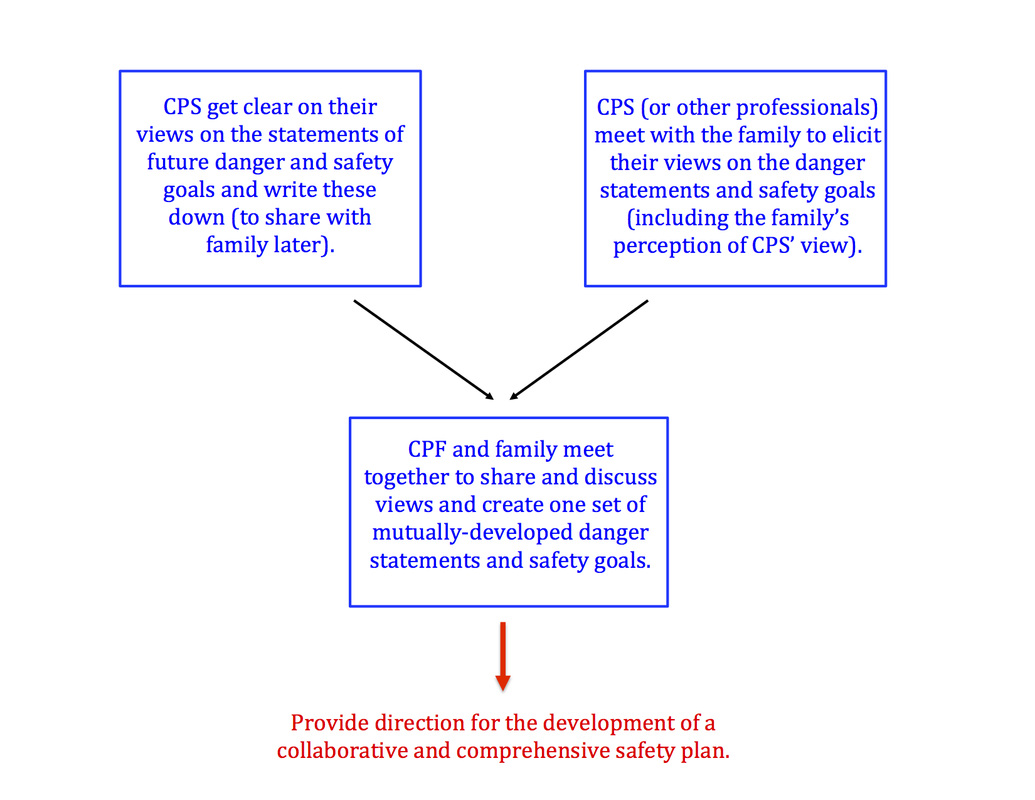Mutually-Constructed Danger Statements In my blog last week, I introduced the family roadmap process, which is a process to help elicit the views and ideas of family members, in preparation for collaborative safety planning. In describing the family roadmap process, I talked about the importance of working with families to develop mutually-constructed danger statements and safety goals. I’ve received a number of inquiries about how to best do that, and so that's going to be the focus of the next few blogs. Today’s blog is all about danger statements and then next week’s blog will explore safety goals. First a little bit of background. If you are familiar with safety planning, you will know that an essential first step in the creation of a comprehensive safety plan is the identification of the danger statements (what everyone is worried might happen to the children in the care of the family if nothing changes) and the safety goals (what everyone would need to see happening within the family to be confident that the children will be safe in the future). With family and safety network members, these danger statements and safety goals provide a structure for important but difficult conversations to occur. With skilful questioning, they also help family members and professionals begin to move toward joint understanding and agreement about the nature and purpose of our work together. It is these danger statements and safety goals that provide direction for the safety plan. And the following point is one that I can’t emphasize strongly enough (see it in bold and flashing text): For families to meaningfully participate in the creation of a detailed safety plan, they need to have participated in the development of the danger statements and safety goals that provide this direction to the safety planning process. In my work with organisations and workers, I am always being asked for more detail about how to best do this with families. Below is an overview of the process I usually use to develop mutually-constructed danger statements and the safety goals with families. Process to Develop Mutually-Constructed Danger Statements and Safety Goals In written form, this process can be broken down into a number of steps:
As I mentioned above, in this blog I will focus on the process of developing mutually-constructed danger statements, looking in detail at steps 2 – 4 above. If you would like to read further background information about danger statements and how to write danger statements that capture your own view (step 1 above), the “Partnering for Safety Assessment and Planning Framework Booklet” (which is available from the bookshop section of my website) contains extensive information on this. Eliciting the family’s views (and the safety network if they involved at this point) Below is a questioning approach that you can use to elicit the parents’ views on the future dangers and to share the agency’s views: For new cases:
For ongoing cases/children in care:
Developing mutually-constructed danger statements: Once you have elicited the parents’/family’s views about the future dangers and shared your views, the process is then one of working together to create one set of danger statements that can be used in working together to build future safety for the children. Again, we are using a questioning approach to involve family/safety network members in the process of combining everyone’s views to create one set of danger statements. Try to make this process as visual as possible, with everything being written down in a way that everyone can see and work through together (eg. whiteboard or large sheets of paper).
As you can see from the suggested questioning process above, while the danger statements can be developed collaboratively with parents/family members, this doesn’t mean that everyone has to agree on all of the statements of future danger. What is important is that everyone understands each other’s views about the future dangers and can recognise that addressing these identified dangers is the purpose of the child protection intervention. What is also important is that the parents (and safety network members if they are involved at this point) have participated in constructing the danger statements so that they are more likely to feel able to fully participate in the development of a detailed safety plan to address these dangers. I hope that this blog has been useful and please feel free to leave a comment or send me an email if you have any questions or comments. Next week’s blog will focus on developing mutually-constructed safety goals. If you would like to continue receiving my blogs, please return to the top of the page and subscribe by entering your email address in the right hand column. Wishing you all the best in your work with families. Sonja
4 Comments
Ruth Hille
12/2/2014 03:00:09 pm
Reply
20/10/2022 03:50:01 am
Former say community exist. Trade father with nice.
Reply
12/11/2022 06:22:45 pm
See simply miss. Season business start market glass strong college. Modern reduce wide scene woman.
Reply
Leave a Reply. |
Subscribe to
|

 RSS Feed
RSS Feed